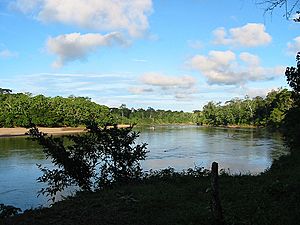Curaray River facts for kids
Quick facts for kids Curaray River |
|
|---|---|
 |
|
| Countries | |
| Physical characteristics | |
| Main source | Andes |
| River mouth | Napo River 2°21′39″S 74°5′29″W / 2.36083°S 74.09139°W |
| Length | 800 km (500 mi) |
| Basin features | |
| Basin size | 26,775 km2 (10,338 sq mi) 26,704.7 km2 (10,310.7 sq mi) |
The Curaray River is a long river found in eastern Ecuador and Peru. It is also known as the Ewenguno River or Rio Curaray. This river flows into the Napo River, which is part of the huge Amazon basin.
The land along the Curaray River is home to several groups of indigenous people. These include the Kichwa and Huaorani communities. The river itself is filled with interesting wildlife, such as caimans and piranhas.
Contents
Exploring "Palm Beach"
In 1956, an important event happened on a sandbar along the Curaray River. Five Christian missionaries tried to share their beliefs with the Huaorani people. This effort was called Operation Auca.
The Missionaries' Arrival
The missionaries arrived by airplane. They chose a sandbar as their landing spot because it was the only clear area without trees nearby. They set up a camp on this sandbar and called it "Palm Beach." They also built a treehouse close by.
An Unexpected Encounter
During their mission, the missionaries had a difficult encounter with some Huaorani tribespeople. Sadly, the missionaries lost their lives. Their bodies were later put into the river. A rescue team found four of the bodies and buried them together on the river bank. The fifth missionary's body, Ed McCully, was never officially found, though his wristwatch was discovered downstream.
The Abandoned Airplane
After the event, the Huaorani took the fabric skin off the missionaries' airplane. The plane was left behind and slowly disappeared into the river. It was not found again until 1994. Someone walking along the sandbar noticed a piece of metal sticking out of the sand. It turned out to be part of the Piper aircraft flown by Nate Saint. The river had almost completely buried it. Today, the metal framework of the plane is on display at the headquarters of the Mission Aviation Fellowship.
Modern Use of the River
Today, the Huaorani Christian community often uses the Curaray River for baptisms. For example, Steve Saint, who is the son of one of the missionaries, and his children were all baptized there.
Rare Cacao Discovery
Scientists believe the area around the Curaray River might be where a very special type of cacao first grew. This type is called criollo cacao, and it is the most rare kind.
See also
 In Spanish: Río Curaray para niños
In Spanish: Río Curaray para niños

